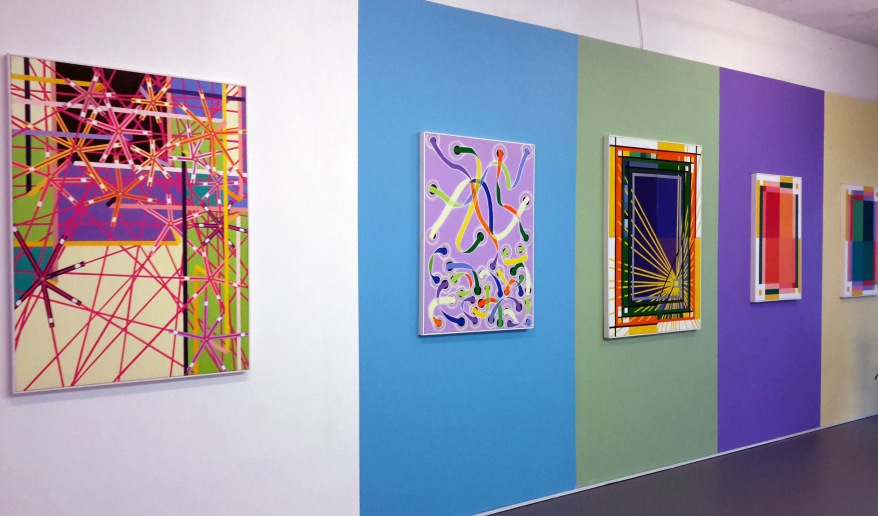Speaking in Tongues: Jo-El Lopez at Gallery Aferro, Reviewed
by Maryann Ficker

(left to right), Classroom Toys acrylic on canvas, 36 x 48 2013, In and Outs acrylic on canvas, 30 x 40 2014, Spirit acrylic on canvas, 36 x 48 2013, Untitled 2 acrylic on canvas, 24 x 36 2011, Untitled 1 acrylic on canvas, 24 x 36 2011
Entering the high ceilinged, spacious, white cube of Gallery Aferro from gritty Market Street in Newark, is like stepping into another world. Upon entering Jo-El Lopez’s first solo show, the dominant theme of high key color created an experience reminiscent of Dorothy’s awakening in Oz. The entry room wall has been painted in five vertical bands of pastel hues, contrasting with the five colorful, abstract paintings displayed on each band. On first glance, the works reminded me of Joseph Albers color exercises, then stained glass windows, then children’s toys. The title of the show, “Speaking in Tongues,” seemed to be a metaphor for the language of color. The harmonized color and patterns, as well as a sense of spirituality and playfulness in these formal, abstract paintings carry over to the figurative work in the main gallery.

Alpha Male acrylic on canvas, 36 x 48 2011
Here iconic portraits and narrative works poke fun at current issues: religion, hipster racism and iphone culture, while also offering serious political commentary on: gun control, American imperialism and civil rights. But there is also a sincere spirituality in the work. In trying to make connections within and between the works, unsuccessfully, at times, I was obliged to do a little online research. There I found explanations for historical references with which I was unfamiliar, and I learned that a number of the works were from Lopez’ series of portraits of gang members, in which he intended to expose their humanity. The meaning in the title of the show expanded greatly. At the same time, I am left unclear about the Lopez’ repeated use of the war bonnet (or Indian headdress). Does it signify defiance against imperialism, is it referring to the act of cultural appropriation or to the appropriation of power?

The Triumph acrylic canvas, 30 x 40 2013
Pedro Alibizu, Campos 26 Years for Freedom acrylic, lottery, tkts, canvas 2015
The range of styles present gives the impression that these works are samplings from multiple bodies of work. There are the abstract paintings, mentioned above. The photo-influenced portraits of gang members are rendered in contrasting colors and use stripes, which remind me of flags indicating allegiance. There are portraits referencing religious icons and more narrative figurative works painted in a graphic, illustrative style with more organic and prismatic patterns. Lopez’ modeling of the face ranges from photographic to illustrative to distorted to almost child like. The artist’s beautiful use of color and graphic patterns in paint contrasts with a number of collage works, of limited palette, made of cut up lottery tickets. In these works the materiality of the intricately patterned mosaic like surface becomes the medium of visual beauty.
A second look at the abstract work in the entry room reveals that they can be read as signifiers of the figurative works in the main gallery, where the stained glass window reference becomes literal. The abstract work, Ins and Outs, might be referring to the topic of discrimination which is addressed concretely in the rest of the work. The subtle shifts of color rectangles in the center of Spirit, Untitled 1 and Untitled 2, can be read as presaging the topic of how we group and separate each other, or ‘put in boxes’, based on subtle and not so subtle distinctions, such as color. Classroom Toys, with its Tinker Toy like web of connections may speak to the idea that we are all connected and learning (or not) how to build those connections.

The Kiss acrylic on canvas, 36 x 68 2015
One of the most powerful paintings present is the thirty-six by sixty-eight inch, The Kiss. Two women parishioners are depicted kissing, seated in front of the stained glass window, depicting Jesus with arms outstretched, which is in the 16th Avenue Baptist Church in Birmingham, Alabama. This is where four young girls were killed in a bomb attack on the church during the 60’s civil rights movement. The women’s touching lips, at the center of the work form both a cross and a vagina. Lopez is relating the civil rights struggle with current struggles for equal rights of women, lesbians and gays, pointing out that the same institutions that lead the struggle for civil rights in the 60’s are also places of discrimination.

Sandy Hook Shooting And The Do Nothing Congress acrylic and lottery tkts, canvas 2013
Lopez’ most effective use of collaged lottery tickets is Sandy Hook Shooting and the Do Nothing Congress. A gun shot riddled Obama, beautifully rendered from a mosaic of cut up lottery tickets, is in front of a hodgepodge painted quilt of GOP Elephants and Democrat Donkeys. The tickets as a medium indicate the lottery-like nature of who will be shot next and reflect Obama’s failure to make a dent in the gun lobby.
Throughout the show, Lopez’ colors and patterns sing. Overall his subject matter is sincere and can be deeply touching, as well as clever and playful. He is not making a choice between truth and beauty, but choosing both, speaking in a multi-layered, multi-hued tongue.
